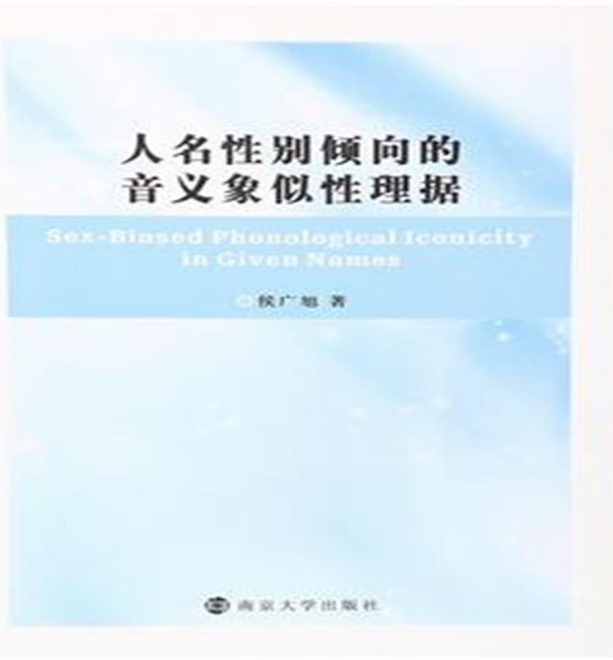《人名性別傾向的音義象似性理據》是2015年南京大學出版社出版的圖書,作者是侯廣旭、姚徽、裴維維。
基本介紹
- 書名:人名性別傾向的音義象似性理據
- 作者:侯廣旭
- ISBN:978730516355
- 頁數:228
- 定價:28
- 出版時間:2015.12
- 裝幀:平裝
- 開本:32
內容簡介,作者簡介,圖書目錄,
內容簡介
本書探討了語言的象似性現象的產生、解釋理據、與隱喻之間的關係.語言符號的象似性研究打破了“語言任意性”原則一統天下的局面 ,為語言學研究向多元化、縱深化方向發展開拓了思路。依據本研究過程與方法,討論了內省式、實證式、語料庫式等語言研究方法的利弊問題,並主要從全息論角度發散式地討論了本研究在語言、文化、哲學等更高、更深、更跨界、更巨觀層面的研究意義。
作者簡介
侯廣旭教授,英語專業學術型碩士生導師(自2003年,首屆),翻譯碩士導(2010年,首屆),南農大英語學科組組長(自2004年),英語碩士點點長(自2004年,首任),英語系主任(自2001年),校文法類教學指導委員會委員(自2005年)。《南京農業大學學報》(自然科學版)、(社會科學版),《高等農業教育》、《三江學院學報》、《三江高教》等英文審訂人,及國家教育部與省教育廳一些項目評審專家。
圖書目錄
目錄 (Table of Contents)
摘要
Abstract
第一章 引言(Introduction)
第二章 男女魅力二元分布的生物學基礎(Biological Basis for Dimorphism of Man and Woman’s Attractiveness)
2.1 男女的一般生物學差異(General Biological Differences between Man and Woman)
2.2 男女魅力的體型二態現象(Size Dimorphism of Man and Woman’s Attractiveness)
2.2.1 腰臀比與男女魅力(WHR and Man and Woman’s Attractiveness)
2.2.2 其它體型特徵與男女魅力(Other Body Shape Features and Man and Woman’s Attractiveness)
2.3 男女發音的生理區別(Physiological Differences of Man and Woman’s Pronunciation)
第三章 音義象似性(Phonological Iconicity)
3.1音義象似性研究回顧(Review of Previous Researches on Phonological Iconicity)
3.1.1 引言 (Introduction)
3.1.2 音義象似性的語言文字學與語言學視角的研究 (Phonological Iconicity Research from the Perspective of Philology and General Linguistics)
3.1.3 音義象似性的心理學視角的實證研究(Empirical Phonological Iconicity Researches from the Perspective of Psychology)
3.1.4 音義象似性的心理學、認知語言學與神經語言學視角的原理研究(Phonological Iconicity Mechanism Research Based on Psychology,Neuro-linguistics and Cognitive Linguistics)
3.1.5 小結(Summary)
3.2 語言象似性原則在音義象似性上的體現(General Iconicity Principles as Manifested in Phonological Iconicity)
3.2.1音義的數量象似性 (Quantity Phonological Iconicity)
3.2.2音義的空間象似性(Spatial Phonological Iconicity)
3.2.3 音義的順序象似性(Linear/Sequential Phonological Iconicity)
3.2.4 音義的模態象似性(Mimetic/Imagic Phonological Iconicity)
3.2.4.1 摹聲(Onomatopeia)
3.2.4.2 模態(Imitation)
3.2.5 認知象似性(Cognitive Iconicity)
3.2.5.1 音叢類比象似性(Clustering Phonological Iconicity)
3.2.5.2 音義的標記象似性(Markedness Phonological Iconicity)
3.2.5.3 音義的交際象似性(Communicative Phonological Iconicity)
3.2.5.4 音義的認知經濟性(Cognitive Phonological Economy)
3.3 語義場理論與音義象似性(Semantic Field Theory and Phonological Iconicity)
3.3.1同一語義場中非反向反義關係單純詞的音義象似性(Phonological Iconicity among Non-Opposite Words within the Same Semantic Field)
3.3.2同一語義場中反義反向關係單純詞的音義象似性(Phonological Iconicity among Opposite Words within the Same Semantic Field)
3.4 音義象似性學說的缺陷(Limitation of Phonetic Iconcity)
3. 4. 1 語言象似性的例外性(Exceptions of Phonological Iconicity)
3. 4. 2 語言音義、形義、語法等象似性的“不完美性”是語言生命力的特質(Exceptions Prove the Rule and Deviations Facilitate Linguistic Vitality)
3. 4. 2. 1 語用對語言象似性的干擾(Pragmatic Interference of Linguistic Iconicity)
3. 4. 2. 1 認知對語言象似性及規則性的干擾(Pragmatic Interference of Linguistic Iconicity)
3.5 音義象似性在人類語言乃至人類文明起源與進化中的作用(Role of Phonological Iconicity in the Origin and Evolution of Human Languages and Civilization)
3.5.1 音義象似性研究是破解人類語言起源與進化奧秘的突破口(Iconicity Provides the Key to Understanding the Origin of Human Language)
3.5.2 從音義象似性到形義、語法象似性的升級推進人類語言的進化---模因論的視角(Phonological, Scriptural and grammatical iconicity Enhances the Evolution of human languages: a Memetic Perspective)
3.5.3 語言象似性對西方文明的推進(Role of Linguistic Iconicity in the Evolution of the Western Civilization)
第四章 以往人名語音性別提示與人名性別偏向的音義象似性研究(Previous Researches on Phonological Cues to and Phonological Symbolism in Gender in First Names)
4.1 人名的性別提示的一般研究(General Researches on Cues to Gender in First Names)
4.2 人名性別的語音學提示研究(Phonological Cues to Gender in First Names)
4.3 人名性別傾向的音義象似性研究(Sex-biased Sound Symbolism in First Names)
4.4 動物名性別傾向的音義象似性(Sex-biased Sound Symbolism in Animal Names)
4.5 結語(Conclusion)
第五章 研究問題、研究材料與方法與研究結果(Research Questions, Materials, Methods and Results)
5.1 研究問題(Research Question)
5.2 研究材料(Research Materials)
5.3 研究方法 (Research Method)
第六章 研究結果、結果分析與討論 (Research Result, Analysis and Discussion)
6.1 研究結果 (Research Result)
6. 1. 1 127個國家與地區的男女常用名整體語音性別傾向的統計結果(Statistical Results on Sex-biased Phonological Iconicity in All Common First Names of 127 Countries, Regions and Communities)
6. 1. 2 127個國家與地區的男女獨立常用名語音性別傾向的統計結果(Statistical Results on Sex-biased Phonological Iconicity in Unique Common First Names of 127 Countries, Regions and Communities)
6.2 結果分析與討論 (Analysis and Discussion)
6.2.1 引言(Introduction)
6.2.3 規則性研究結果的討論(Discussion on Regular Results)
6.2.4 非規則性研究結果的討論(Discussion on Irregular Results)
6.2.5 人名性別傾向的音義象似性的總體理據驅動(Sex-biased Phonological Iconicity in Given Names: General Motivation)
第七章 結語 (Summary)
7.1結論(Conclusion)
7.2 本研究的局限性(Limitations of the Research)
7. 2. 1 研究材料的局限性(Data Limitations)
7. 2. 2 人名的語言與民族性差異干擾(Interference of Linguistic and Ethnic Diversity)
7. 2. 3 男女生物學魅力的民族多樣性干擾(Interference of Ethnic Diversity of Man and Woman’s Physical Attractiveness)
7. 2. 4 研究者的自身局限性(Limitations of Researcher)
7.3 對未來研究的建議--人名性別傾向音義象似性研究對相關套用性研究與語言研究方法的啟示 (Suggestions for Future Research: Practical Implications of the Present Research on the Related Applied Research and the Linguistic Research Methodology)
7.3.1 人名性別傾向音義象似性研究對相關套用性研究的啟示(Implications on the Related Applied Research and the Linguistic Research Methodology)
7.3.2 人名性別傾向音義象似性研究對語言研究方法的啟示(Implications on the Linguistic Research Methodology)
7.4 人名性別傾向的音義象似性探索在語言、文化、哲學層面的研究意義(Cultural and Philosophical Implications of the Present Research)
參考書目 (References)
索引 (Index)
後記 (Epilogue)
附錄I 127個國家與地區的前十個常用女名(List of Top Ten Popular Female Given Names of 127 Countries, Regions or Communities)
附錄II 127個國家與地區的前十個常用女名( List of Top Ten Popular Female Given Names of 127 Countries, Regions or Communities)
附表III 127個國家與地區的獨立男名(Unique Male Given Names of 127 Countries, Regions or Communities)
附表IV 127個國家與地區的獨立女名(Unique Female Given Names of 127 Countries, Regions or Communities)

